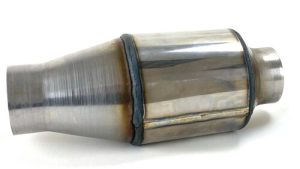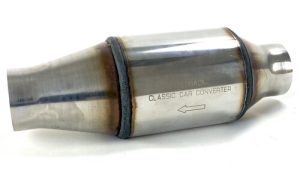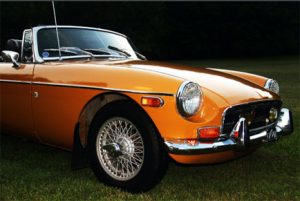Classic Car Converters with European and US Patents
European patent approval (EP3511541)
US patent approval (US 10,605,139 B2)
← For individual product information and to order use the search function…
Happy to announce that applying two of your smaller Classic Car Converters to my Healey 3000 has been very successful. Installed right in front of the silencer (Denis Welch side exhaust). Removed 90% of the HC from the exhaust gas – now almost smell free – and no power loss at all!
Finn, from Denmark
Just wanted to say how delighted I am with the catalytic converter I have now fitted to my Land Rover. My wife can’t believe it’s the same old car now it’s not emitting all those fumes!
Richard, from the UK
Jetex are pleased to be able to offer a trio of catalytic converters that have been designed specifically for the classic car market. A unique converter design allows a dramatic reduction in exhaust smells and harmful emissions without the noticeable loss of performance.
There are 3 sizes of converter:
-
Converter 1 is 101.6mm in diameter with end cones to fit 57mm pipework.

(We can supply extra stepped adaptors to reduce this diameter further to 42mm or 38mm. Our stainless adaptors can be ordered here or aluminised version here. Alternatively the cones can be trimmed back to suit larger diameter pipework).
-
Converter 2 is 83mm in diameter with end cones to fit 45mm pipework.

(Adaptors are already included to reduce this diameter further to 54mm or 51mm. Alternatively the cones can be trimmed back to suit larger diameter pipework).
-
Converter 3 is 72mm in diameter with end cones to fit 30mm pipework.

One of the downsides of owning a classic car is the heavy and choking exhaust smell, which is hazardous to your health. The Classic Car Converter eliminates this smell, making your driving experience more pleasing.
Whether petrol is burned at an optimal air/fuel/oxygen ratio, or too lean or too rich, the combustion of petrol creates emissions that include harmful gases, such as Nitrogen Oxides (NOx), Hydrocarbons (HC), Carbon Dioxide (CO2) and Sulphur Dioxide (SO2).
These harmful gases affect humans through the impairment of the immune system and development of respiratory diseases, while environmentally help to create acid rain and accelerate ozone depletion.
The Classic Car Converter also significantly reduces Hydrocarbon (HC) and Nitrogen Oxide (NOX) emissions – a range of gases that are well known to be harmful to people and the environment.
How Does the Converter work?
Exhaust gasses containing Carbon Monoxide (CO), Hydrocarbons (HC) and Nitrogen Oxides (NOX) enter the converter.
The gasses pass through the substrate which is coated with a combination of precious metals.
A chemical reaction takes place when the converter is at an operating temperature of 280°C. Less harmful exhaust gases leave the converter, including Carbon Dioxide (CO2), Nitrogen (N) and Water (H2O).
The graphs below show reductions of HC of up to 35% and NOX of up to 58%. These figures were obtained using a 1970 Ford Mustang 5.8L V8.



Important Fitting Notes
The Jetex Classic Car Converter has been designed to perform on pre-catalytic converter vehicle models. It is important that the following fitting instructions are read carefully.
The converter has been manufactured with a short and long set of cones to improve gas flow and performance. The short spun cone needs to be fitted towards the engine side of the vehicle to allow the exhaust gases to flow freely into and through the catalyst.
The converter needs to be fitted within approximately 1m (100cm) of the engine so that the exhaust gases can heat the converter to the minimum operating temperature of 280°C. This temperature allows the converter to convert the exhaust gases.
If required, two adaptor tubes are included for easier installation. Jetex also offer other fittings as part of our custom exhaust parts range. The converter and adaptor tubes should be welded to the vehicle’s exhaust system to prevent any leaks and allow the converter to function correctly.
It is important that the vehicle’s engine is tuned correctly. If not, this can cause the converter to perform at a sub optimum level and possibly cause damage to the converter.















Comments are closed.